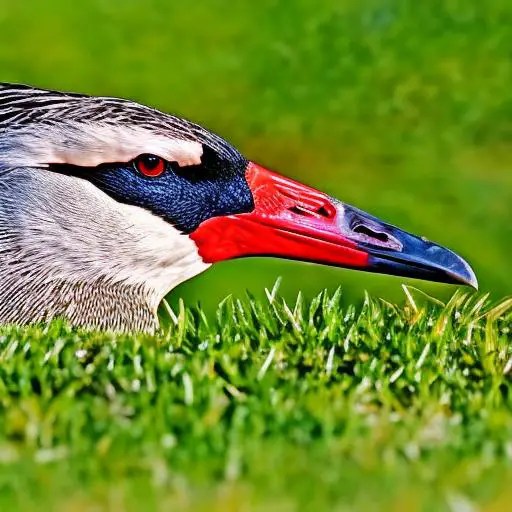Conquer Your Goose Problem: Reclaim Your Lawn!
Is your beautiful lawn under siege by a flock of feathered invaders? Geese, while majestic in flight, can be a real nuisance when they decide your grass is their personal buffet. Their droppings can ruin your picnic plans, and their aggressive hissing can make your yard feel less welcoming. But don't despair! Reclaiming your lawn is possible. This guide will provide you with a comprehensive arsenal of tactics to deterring geese and keeping them off your property for good.
Geese are attracted to large, open areas of short grass near water, making manicured lawns an ideal spot. This preference stems from their natural habitat and feeding habits. Historically, geese have thrived in wetlands and grasslands, and your lawn mimics these environments. The importance of goose control lies in maintaining the aesthetic appeal and usability of your lawn. Goose droppings not only create an unsightly mess but also pose health risks, as they can carry bacteria and parasites. Furthermore, large goose populations can damage the grass itself through excessive grazing and trampling.
The main issue with goose control is finding humane and effective methods. Some tactics may deter geese temporarily, while others offer more long-term solutions. Understanding goose behavior is key to implementing a successful goose deterrent strategy.
One simple deterrent is making your lawn less appealing to geese. This involves disrupting the features they find attractive. Taller grass makes it more difficult for them to spot predators, so letting your grass grow slightly longer can help. Eliminating access to open water sources, like ponds or leaky faucets, is also crucial. Geese need water to drink and bathe, and removing these resources can significantly discourage them from settling on your property.
Another effective strategy involves creating visual or auditory deterrents. These can range from simple scarecrows and reflective tape to more sophisticated motion-activated sprinklers and ultrasonic devices. These methods exploit the geese's natural wariness of unfamiliar sights and sounds, effectively scaring them away.
Benefit 1: A cleaner, healthier lawn. By preventing geese from congregating on your property, you eliminate the unsanitary mess created by their droppings, reducing the risk of diseases and parasites.
Benefit 2: A more enjoyable outdoor space. Without the constant presence of geese and their potential for aggressive behavior, you can fully enjoy your yard without fear or frustration.
Benefit 3: Protecting your lawn's health. Excessive grazing and trampling by geese can damage your grass, requiring costly repairs. Deterrent methods safeguard your lawn's appearance and overall health.
Action Plan: Start by identifying the factors attracting geese to your property. Is it the short grass, readily available water, or lack of deterrents? Once you understand the problem, implement a combination of strategies. For example, allow your grass to grow a bit longer, install a motion-activated sprinkler, and add some visual deterrents like reflective tape or balloons. Regularly evaluate the effectiveness of your approach and adjust your tactics as needed.
Advantages and Disadvantages of Goose Control Methods
| Method | Advantages | Disadvantages |
|---|---|---|
| Border Collies | Effective, humane | Can be expensive, requires training |
| Motion-activated Sprinklers | Relatively inexpensive, effective | May not deter all geese, can increase water bills |
Best Practices: 1. Consistency is key. Maintain your chosen deterrent methods consistently to reinforce their effectiveness. 2. Combine different strategies for a more comprehensive approach. 3. Target the root cause. Address the factors attracting geese to your property. 4. Be patient. It may take time to see significant results. 5. Monitor and adapt. Evaluate the effectiveness of your methods and make adjustments as necessary.
Challenges and Solutions: 1. Geese become habituated to certain deterrents. Solution: Rotate methods or combine strategies. 2. Neighboring properties attract geese. Solution: Collaborate with neighbors on a community-wide approach. 3. Limited budget. Solution: Explore cost-effective options like DIY deterrents. 4. Difficult terrain. Solution: Adapt your methods to suit the specific landscape of your property. 5. Persistent geese. Solution: Contact a professional wildlife control service.
FAQ: 1. Are there legal restrictions on goose control? 2. What are the most humane goose deterrent methods? 3. How do I prevent geese from nesting on my property? 4. Will geese harm my pets? 5. Can I feed geese to keep them away from my lawn? 6. Are there any natural goose repellents? 7. How often should I apply goose deterrent sprays? 8. What should I do if a goose attacks me?
Tips and Tricks: Use flashing Christmas lights. Place fake predator decoys strategically around your property. Create a barrier using string or fishing line. Spray a mixture of grape juice and water on your grass. Use a dog whistle to deter geese.
Keeping geese off your lawn is achievable with the right approach. By understanding their behavior and implementing effective deterrent strategies, you can reclaim your outdoor space and enjoy a goose-free lawn. Remember that consistency is crucial, and combining different methods often yields the best results. A goose-free lawn enhances your property's aesthetic appeal, promotes a healthier environment, and allows you to fully enjoy the benefits of your outdoor space. Don't let these feathered foes conquer your yard – take action today and start enjoying the peace and tranquility you deserve. Take back your lawn and make it yours again. Don't let geese dictate your outdoor enjoyment. Start implementing these strategies today and reclaim your green space!
Behind the walls understanding bare hill correctional facility
Jennifer lopez current hairstyle stealing the show with effortless glamour
Forearm rose tattoos a timeless symbol of femininity and strength














